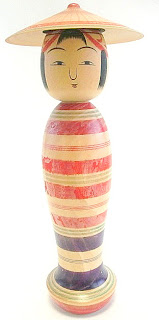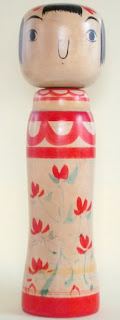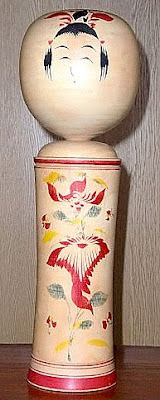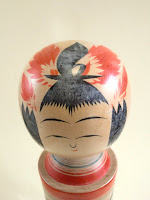The Origin of Kokeshi_2
The Journey of Discovering Origin of Kokeshi
[description]
- name :AkaBeko
- kind : papier-mache
- production area : Aizu,in Tohoku
- tall : 10cm(4inch)
- width : 12cm(5inch)
"Why the people accepted dolls with no limbs?" - one of the most usual detections is,"there must had been preceding dolls alike to kokeshi - that is, if there had been dolls alike to kokeshi before,the people would have accepted latecomer odd-shaped kokeshi easily.Then,researchers went to the journey of discovering "the origins of kokeshi" - I'll introduce some examples of their discoveries.
Some say,"there are several kokeshi-like dolls discovered from certain remains of Kyoto,the ancient capital in Japan,which are estimated to have been made in 9th.They has no limbs,so they might be the origin of kokeshi."
Others say,"there had been phallic worship in the ancient time in the world around,and there had been sculptures of phalluses discovered in certain areas in Japan as well.Kokeshi are alike to phalluses,and the icon memory of the ancient worship may still remain in our deep psyche.So,they might be the origin of kokeshi."
Irrefutable Theories
Great - as for the first opinion,"Expand wider range of search areas,and we can find the origins in more areas" - I'm sure there are too many simple and primitive dolls alike to kokeshi buried all over the world.We may find the origins even in Lascaux,and someone can say "the origin of modern abstract art was in Lascaux,today,we discovered the origin of kokeshi is in Lascaux as well" - now,kokeshi is registered as a World Heritage...
As for the second,it seems just like "dream interpretation" - a psychiatrist says to me,"you seem to be attached to kokeshi.But actually,it is just reflection of your much sexual frustration.Because kokeshi is the symbol of phallus" - I'm so dumb,and feel so sorry about kokeshi because it was just an outlet for my sexual frustration.
I have read that old kokeshi artisans had crafted some of wooden phalluses wickedly - but actually,they did so based on their beliefs -phallic worship-,not just wickedly.And kinakina,originally a baby's pacifier(dummy),was deliberately intended for their oral stage -I'll be really dammed!! - I'll list a picture of kinakina again left for your self-analysis.
Actually,these opinions seem quite empty answers- because they ignore an important context of the question -"When" and "Where".
On the last post,I mentioned the opinion of Alan Booth(cf."The Origin of Kokeshi_1").His theory assumed the following points:
- Kokeshi prevailed especially in Tohoku,north-east region in Japan
- Kokeshi prevailed from Edo period,about 18th-19th
So,he thought -there had been some horrible famines in Edo period,and Tohoku had been especially damaged so heavily that the people had killed their babies for their heavy starving.Therefore he concluded - "kokeshi may in origin have been fetish substitutes for children murdered at birth".
I think his opinion is more comprehensive and (therefore) more persuasive than "the theory of ancient doll-origin" or "the theory of phalluses or some such-origin".
Advocates of both theories had to disprove the above facts with more evidences that kokeshi had prevailed nationwide in Japan as much as in Tohoku region.
Or, if they thought kokeshi had disappeared in almost Japan except Tohoku region,they had to explain the reason why they had disappeared in many areas and had been left only in Tohoku.
Indeed,even though I can acknowledge the possibility that ancient dolls or sculptures might affect kokeshi artisans as their inner imagination,I can't accept these theories without evidences of direct relation between them and kokeshi - for example,"phallic worship prevailed especially in Tohoku".
The point is "kokeshi in Tohoku".I think none of opinions are persuasive without solving the matter of Tohoku region.
(So,I can still understand the following opinion:"Kokeshi might be just by chance the invention by some artisans in Tohoku,in Edo period" or so -apart from its persuasiveness,this is more straightforward.)
Next time,I'll introduce more comprehensive opinion than the above opinions - Kunio Yanagita,a Japanese folklorist's opinion.















